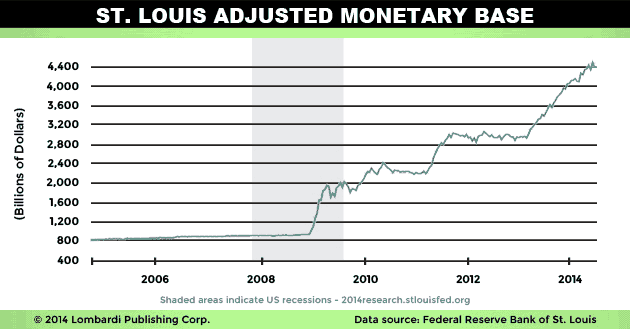There’s a big problem brewing ... one that I started warning about two years ago: food and basic commodities prices are skyrocketing.
In April, the Producer Price Index (PPI), an index that tracks prices paid by producers for commodities, increased by the most in 19 months. The month-over-month change was 0.6% -- yes, that is an annualized inflation rate of 7.2%. (Source: Bureau of Labor Statistics web site, last accessed May 20, 2014.)
Hedged Production
Generally speaking, the producers (the companies that grow/import the food we eat and make the goods we buy) are “hedged” in the short term so consumers won’t see a jump in prices right away; consumers will see prices rise in the months ahead.
While some economists are saying food prices are rising because we had a terrible winter and the weather played havoc with harvests around the world, I simply think too much money has been created out of thin air over the past five years, too many dollars are in circulation, the U.S. dollar is falling in value against other world currencies and that is pushing up domestic prices for goods, causing inflation.
This chart explains the situation very well. It shows how much currency there is in circulation in the U.S. economy. You can easily see that after 2008, our monetary base exploded.

Hyper Inflation
As the chart shows, there is no denying we are experiencing hyper-monetary inflation in the U.S. There’s simply too much money in circulation. (You can thank the Federal Reserve for that.)
Understand this: when inflation increases, your buying power goes down. Today, your dollar is worth less than it was last year, last month, or even last week.
What’s so interesting is how investors have been so caught up with rising stock prices that they are completely ignoring the best hedge against inflation -- gold bullion.
My concern is that consumers are being misled as to what the real inflation rate is in America and how their money is simply buying less and less than it used to.
In its most recent economic projection of the U.S. economy, the Federal Reserve forecasted inflation will be in the range of 1.5%-1.6% this year and between 1.5% and two percent next year. (Source: Federal Reserve web site, last accessed May 20, 2014.) But these projections are far too low and too conservative.
According to the Bureau of Labor Statistics (BLS), consumer prices rose by 0.3% in April alone—that’s 3.6% annualized. (Source: Bureau of Labor Statistics web site, last accessed May 20, 2014.)
Long-term readers of Profit Confidential have read here how the “official” inflation figures are manipulated to make inflation look lower than it really is; they don’t include the rise in prices of two items consumers use daily -- food and gas.
As inflation keeps rising and as your dollars are worth less and less, we really need to ask the question: is money really worth anything anymore? Sure, it will always be worth something. It will just take a lot more of them to make purchases for the goods we need daily to survive.